The name “sparrowhawk” comes from the prey (sparrows) of some species of sparrowhawks, and does not refer to the size of the raptor itself.
The African Black Sparrowhawks (Accipiter melanoleucus) are relatively large in size, with a wingspan of 100 to 110 cm. They prey mostly on medium-sized birds. The female is noticeably larger than the male, and so females tend to target larger birds, the size of francolins for example, and males favour more dove-sized prey. Their preferred habitat is forests and woodlands where they build their nests in tall trees. Plantations, and even stands of mature pine or eucalyptus trees, and the high number of doves and pigeons in urban neighbourhoods account for Black Sparrowhawks successfully adapting to such areas.
Our garden backs onto a commercial exotic eucalyptus plantation. Along the fringes of the suburban backyards in our street, old “stray” eucalyptus trees provide suitable nesting sites for raptors, including Black Sparrowhawks and Crowned Eagles. Directly behind our garden a pair of Black Sparrowhawks used to nest in an old and very tall eucalyptus, returning to the same nest year after year.
The nest was constructed one stick at a time to comprise hundreds of stacked up and interlaced sticks collected by both birds in the monogamous breeding pair. At breeding time, the nest is lined with green leaves from the host tree, commonly eucalyptus or pine. It is thought that the aromatic leaves protect against parasites. The height from the ground varies, but often nests are very high up in tall trees. The pair nesting behind our house built their nest in a fork against the main trunk, with the nest being about 15 metres from the ground.
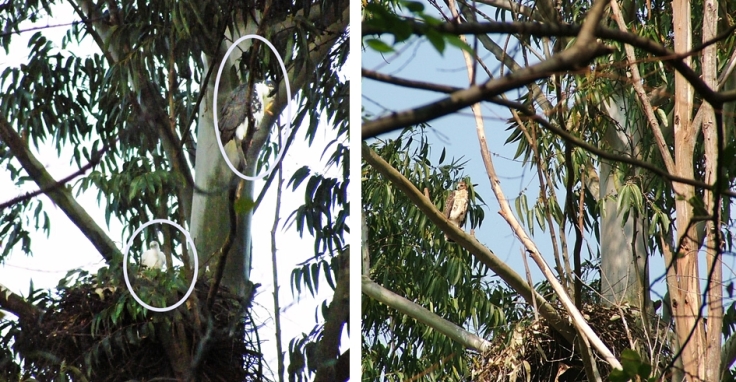
In their first breeding season in our neighbourhood, when we were able to get a clear view of a pair of snow white chicks (superficially and from a distance resembling fluffy chickens), I did not have an adequate zoom lens, so the pictures above will have to suffice. In the photo on the left I have circled a white chick on the nest with the female above (having a good scratch) and in the picture on the left the mottled brown subadult chick can be seen to the left of the nest
Over a period of about six years, the pair of Black Sparrowhawks returned each year to build up and strengthen the nest with more sticks. They are very vocal around breeding time with a loud call, which to my ear resembled the sound that some old-fashioned teddy bears made when a button on the abdomen was pressed (how many of you remember teddy bears like that?) so I nicknamed them the teddy bear birds.
Usually they raised one or two chicks in one brood per year, but one year they successfully raised three chicks to subadult status. When all goes well, prey species are plentiful, and the parents hunted most avidly early in the morning and at dusk. During their years here the numbers of Tambourine Doves declined, and after a time Laughing Doves and Redeyed Doves were seldom seen at all. Once we saw the female perching in a tall tree in our garden and when a small group of Hadeda Ibises flew past, she dashed out and grabbed one in full flight, to the noisy consternation of the unfortunate Hadeda’s flying companions.
But, many threats face the hardworking Sparrowhawk parents. One year, we had protracted unseasonable cold and wet weather – difficult weather for hunting. Sadly, we found the emaciated corpses of two fully-fledged subadult chicks at the foot of the nesting tree. We assumed they had succumbed to starvation.
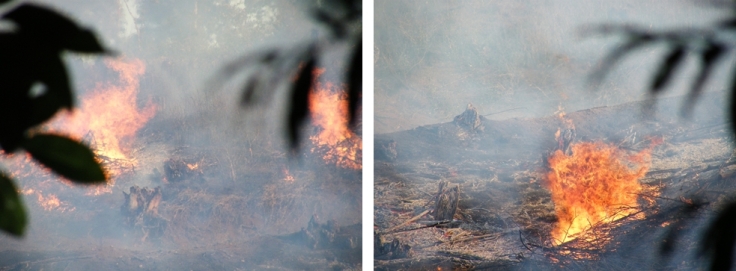
In the dry winter months, plantation fires can be a disruptive hazard. This fire was eventually extinguished by firefighters using beaters and water pumped from tankers, with additional backup from aerial water bombers, airplanes fitted with water tanks, dropping water onto the fires
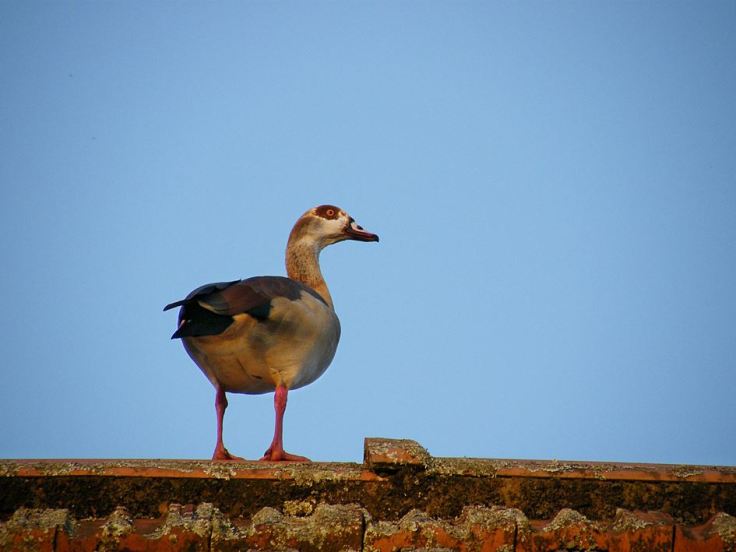
Egyptian Geese pose an unexpected threat to nesting Black Sparrowhawks, as the geese try to take over their nest. As the geese are much larger and heavier than the sparrowhawks, they and their eggs or chicks, often come off worst in such encounters. I have been told of an adult male Black Sparrowhawk being killed by a pair of parent Egyptian Geese, when the sparrowhawk tried to snatch a gosling. The pictured goose, perched on the roof of our house, and its mate frequently harassed “our” pair of sparrowhawks who managed to successfully defend their nest and their young. Each year after several days of noisy “warfare” the geese eventually backed off. For more on geese and sparrowhawks see here
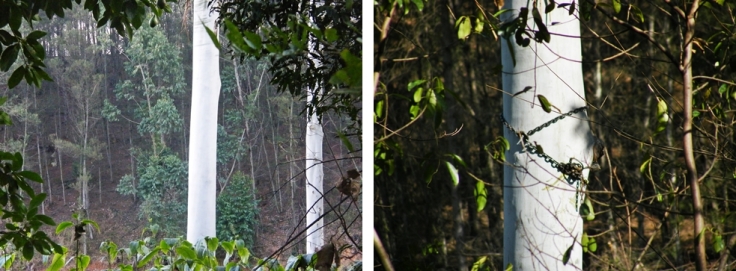
Pictured above are some of the old eucalyptus trees just outside our backyard that were beyond the margins of the plantation and so had escaped the regular tree fellings and were left to grow into enormously tall trees
In the small valley between us and the plantation proper is a small water course, which is usually a dry stream bed. The large trees are thirsty. As part of a policy to improve streamflow such alien trees are targeted for removal. In the photo above on the right, a chain can be seen around the trunk of a tree as it is prepared for felling. For the larger trees, a chain is secured to a winch, mounted on a tractor. A forester using a chain saw fells the tree and the winch and chain ensures the tree falls in a predetermined location.
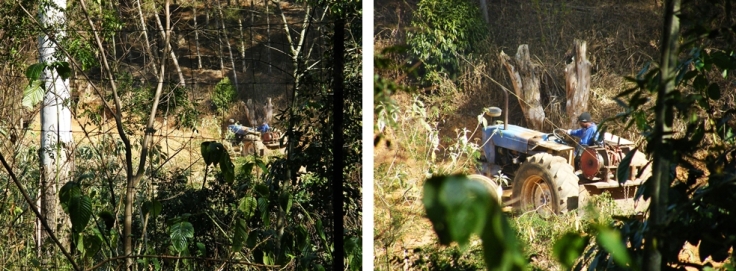
The taut winch line from the tractor to the tree can be seen as the tree is prepared for felling
As the trees further up the valley were felled, we discussed how best to protect the tree in which the Black Sparrowhawks were nesting. Their chicks had recently hatched. But the felling stopped and the project seemed to be over and it seemed the birds might be left to raise their young, at least for this season.
But a few weeks later I got home from shopping, and as I approached the kitchen door with my bags of groceries I heard a chain saw fired up near the base of the nesting tree. I dropped the shopping and rushed out through our back gate and ran through the undergrowth to the foresters clearing the brush at the base of the nesting tree. Pointing up to the birds nest I pleaded with them not to fell the tree, saying that I would contact the head office to ask for permission to spare this tree. Fortunately, they agreed and moved on to another tree.
I phoned the manager in charge of this part of the plantation, and he said if I put hazard tape around the base of the tree to mark it, they would leave it. This I did. The sparrowhawk’s nesting tree was to be spared. But all around them, there was the smoke of exhaust, the noise of chainsaws and tractors, and the crashing sound of falling trees.

Now you see it, now you don’t. The demise of a tree only 30 metres from the Black Sparrowhawks’ nesting tree
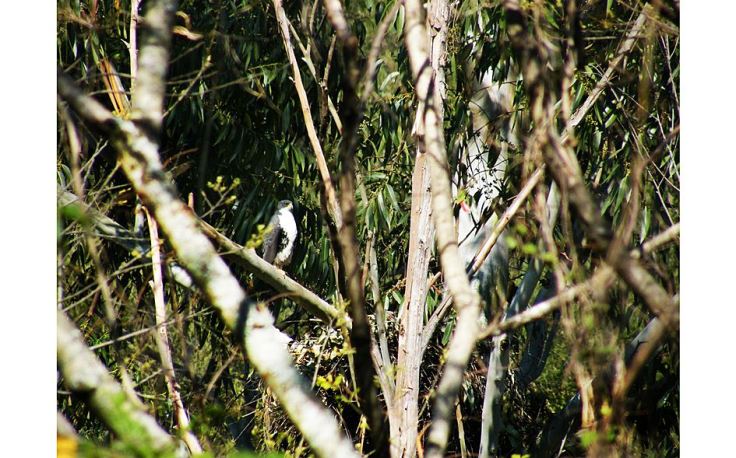
The female sparrowhawk remained steadfast, remaining with the chicks throughout the period of the tree felling all around her. Sadly, the male disappeared
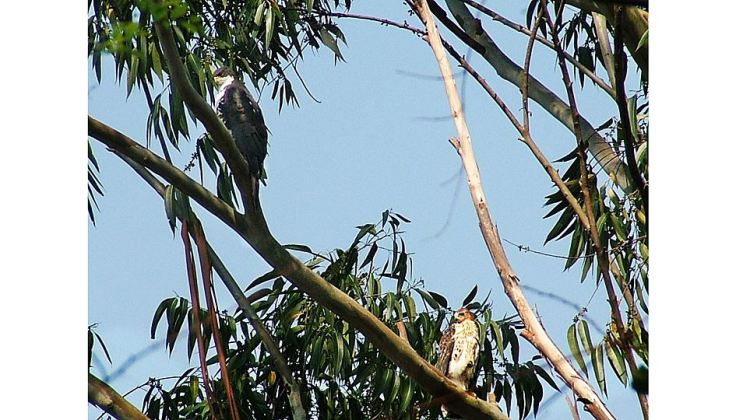
Usually a pair of Black Sparrowhawks raises the chicks together. After the disappearance of her mate, the female went on to raise one chick on her own. It seems that the second chick must have died while still very young
So although adapting to exotic plantations as a survival strategy has served the Black Sparrowhawks reasonably well in recent decades. Ironically, that strategy has now become an insurmountable hazard as exotic trees are being systematically removed. Habitat destruction comes in many forms and from unexpected sources.
The following year, we were pleased to hear the teddy bear sounds of a Black Sparrowhawk. We saw what we assumed to be the same female back again in her favourite roosting tree (that had not been felled) not far from the nesting tree. She and her partner had been white morps, the whiter variety of the Black Sparrowhawk. But this year, she had found a new mate, a black morph.
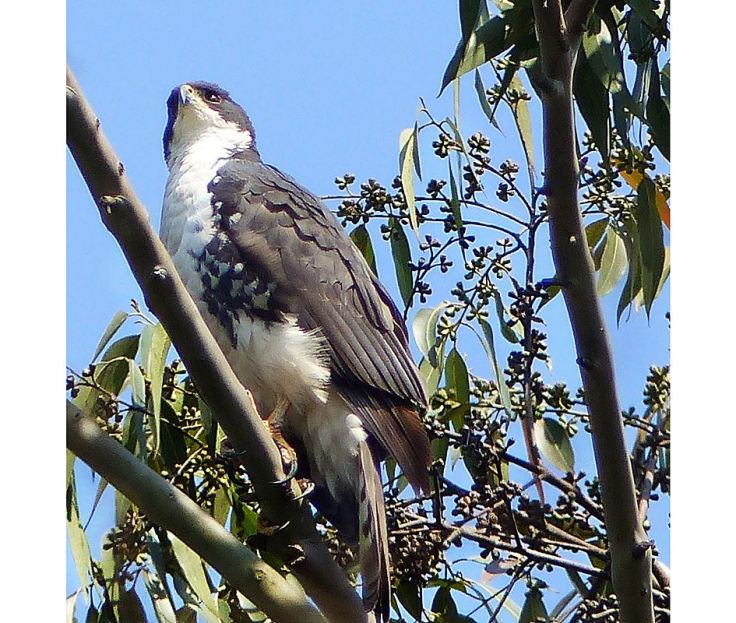
The female Black Sparrowhawk, a white morph, perching above the nest in the eucalyptus tree
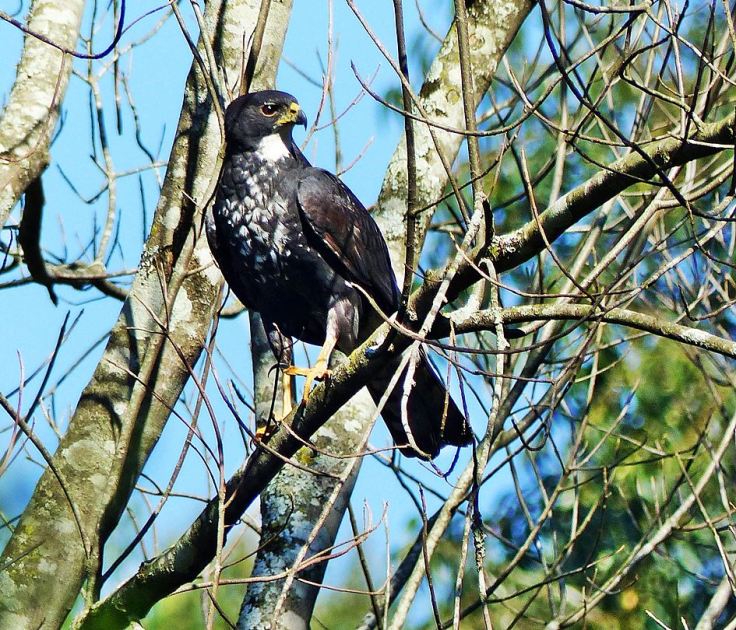
The male sparrowhawk, a black morph in our garden. He was breaking sticks off this bare tree to use to rebuild the nest
The pair started work rebuilding the nest. Unfortunately, the Egyptian geese arrived and started harassing them mercilessly. This time, the female and her new partner gave in and moved away to find another tree. We heard them calling over the next two weeks and it seemed they were building a nest in the plantation. But then we heard them no more. Either they been hurt or killed or decided to move on. Last year, we saw a sparrowhawk calling from what had been the favourite perching tree, but she was alone and only stayed for two days.
And the Egyptian Geese? Once they had displaced the sparrowhawks from the nest, they stayed only a few days and they too moved on. Since then the nest has pretty much disintegrated. We wonder what will happen this year.
Although we miss the magnificent presence of the Black Sparrowhawks, we now have a resident pair of Redeyed Doves and a pair of Laughing Doves in our garden every day. We hear the Tambourine Doves calling, but never see more than one at a time in the garden. Things change.
For an interesting 2012 interview with Ann Koeslag of the Cape Peninsula Black Sparrowhawk Project, see here
Sources: Black Sparrowhawks of the Cape Peninsula https://blackspar1.wordpress.com/; Planet of Birds Black Sparrowhawk (Accipiter melanoleucus) http://www.planetofbirds.com/accipitriformes-accipitridae-black-sparrowhawk-accipiter-melanoleucus
Posted by Carol

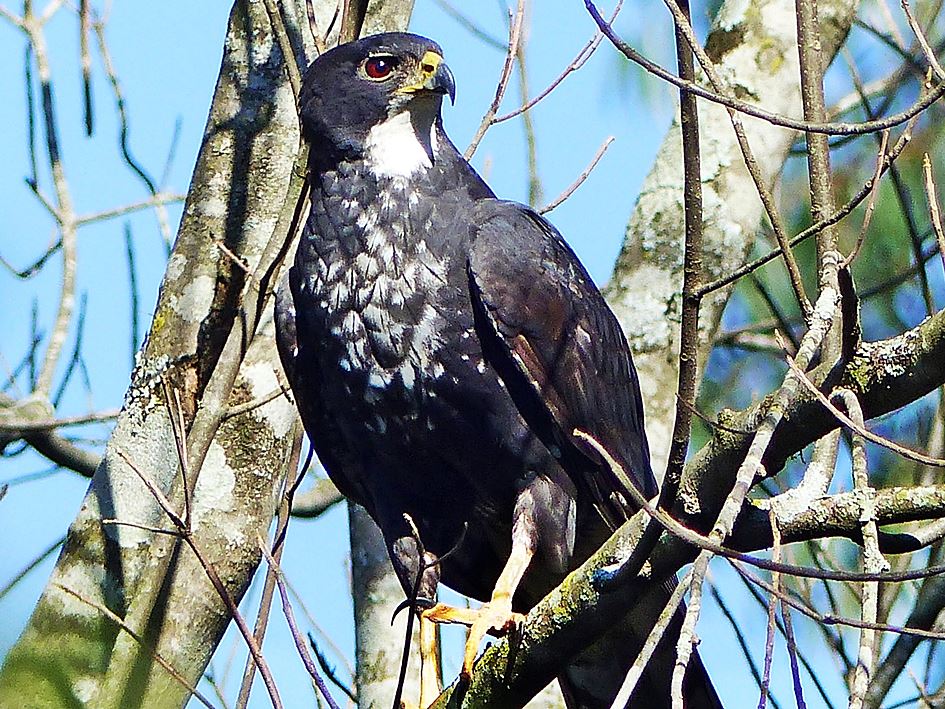







March 17, 2017 at 4:12 pm
What an experience, to have such birds so close and be able to watch them. They go, and the doves return: nature never stands still.
Here we enjoy watching the buzzards, always a majestic sight. This week I heard a difference in the usual mewing call of the buzzard. It sounded distressed and indeed it was: a buzzard was being mobbed by a single seagull. I’ve seen crowds of crows do this if they perceive the buzzard as threatening their young but the seagull would not be nesting in this vicinity and it’s too early anyway. Despite their size, buzzards are fragile birds. The vicious beak of the seagull could certainly inflict damage. On this occasion it reached the safety of a tree across the valley where I watched the seagull circling before finally giving up. Thankfully, seagulls can’t land in trees!
LikeLike
March 19, 2017 at 6:42 am
Thanks Sandra. It seems that raptors have a harder time than is generally realised.
LikeLiked by 1 person
March 17, 2017 at 10:16 am
Dear Carol, most interesting article. You are so fortunate to be able to be living so close to nature and experiencing all its wonders.
LikeLike
March 17, 2017 at 10:30 am
Hi Suzette. Thanks very much, and yes we are fortunate. It is sad to note that even in our neighbourhood on the edge of town, the noticeable birds and creatures seem to be reducing in number as the years go by, and the invasive alien plants are becoming even more rampant. Perhaps it can add up to something meaningful if we all try to be more caring of the natural world and accommodating to the creatures, many of which are struggling to survive, and many of which we fail to notice?
LikeLike
March 17, 2017 at 9:13 am
Yes, a very interesting read. Our only encounter with a suburban sparrowhawk occurred when we lived on the edge of Harrogate. A sparrowhawk careered out of the sky and wham! into our garden fence. Surely he must have been quite young to make such an error? He was dazed, but shook himself down, and after a few seconds, stumbled back into the sky. Yours is a much more positive story.
LikeLike
March 17, 2017 at 9:49 am
Gosh yes, it could have been a youngster to make that mistake. Hope it recovered. However and unfortunately, powerlines and fences are hazardous to many birds in flight, including raptors.
LikeLiked by 1 person
March 17, 2017 at 4:35 am
How fascinating! What a privilege to have enjoyed these Sparrowhawks nesting nearby over time – I had no idea they would have to fend off Egyptian Geese either. This has been such an interesting read.
LikeLike
March 17, 2017 at 6:21 am
Thanks Anne. And yes it was a privilege.
LikeLike